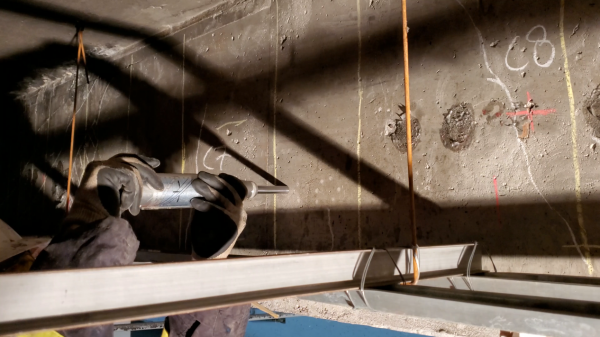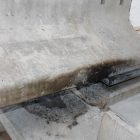In this article, and presentation, we are going to describe using non-destructive evaluation of cracking in concrete beams. The main reasons behind cracking is discussed. A systematic approach for evaluating the current condition of the beam is presented. Certain features of concrete cracks, such as the crack width and crack depth are measured using NDT methods. GPR scan is used to determine structural detailing of beam, such as the location and spacing of stirrups, as well as cover thickness. Ultrasonic Pulse Velocity is used to assess concrete crack depth, whereas Ultrasonic Pulse Echo is used to determine the overall thickness of the element from on-side only. Finally, rebound hammer test (Schmidt hammer) was used to verify uniformity and concrete strength.
What is a Crack ?
In this article, we are going to describe how to use non-destructive testing for evaluation of cracks in a concrete beam element. Cracks are the most common sign of defects in concrete elements, however, not all cracks are born equal. While dormant cracks have no serious impact on durability or structural performance of the structure, more severe cracks can be a sign of distress, and structural deficiency. First, let’s see what a crack is?!
A crack is a linear fracture in concrete which extends partly or completely through the member. Concrete is a relatively good material in compression; however, it can easily break as a result of tensile stresses.
Why Does Concrete Crack?
Several issues can result in cracks in concrete, including:
- excessive external loads,
- external restraint forces,
- internal restraint forces,
- differential movements,
- settlements,
- corrosion of reinforcement.
In a concrete beam, tensile stresses are initially carried by the concrete and reinforcement. When the tensile stresses in the beam exceeds the tensile capacity, the concrete cracks. After this point the tensile force is transferred completely to the steel reinforcement. In a concrete beam, the crack widths and their distribution is mainly controlled by transverse reinforcement, or simply the stirrups.
Cracks resulting from externally applied loads initially appear as hairline cracks and are harmless. However, as the reinforcement is further stressed the initial cracks open up and progressively spread into numerous wider cracks.
Now that we have now why and how concrete cracks, let’s get back to our first question. How can we evaluate cracks in concrete?
Evaluation of Cracking in Concrete Beams
1. Close-Up Inspection
A systematic assessment often starts with detailed close-up visual inspection of the element. The cracks and other surface defects are identified and marked. For each crack, two pieces of information are collected:
- Crack Width
- Crack Depth.
2. Crack Width Measurement
Crack widths can provide an indication of the severity of the cracks. Crack widths can easily be measured using a simple crack width ruler. Modern applications using image processing techniques, or laser scans can also help study the distribution and width of cracks.
While hairline cracks might not impose serious risk on structural integrity, wider cracks can be a sign of severe distress and require repair or retrofitting.

3. Crack Depth Measurement
Crack depths on the other hand, can be used to study the structural integrity, and durability performance of the concrete beam. One simple NDT method for estimating the crack depth is the ultrasonic pulse velocity or simply UPV.
In this particular application, the sending transducer is placed on one side of the crack, while the receiving transducer is placed on the other side. First the sensors are placed at a distance D, and the transit time is measured. Later, the distance is increased to 2xD, and the test is repeated. Then the results are used to estimate the cracks depth.
Crack depth can show if the surface defects propagate deep into the element or are limited to the surface, thus helping engineers in evaluating structural integrity.
4- Structural Details using GPR
Another great technology is Ground Penetrating Radar or simply GPR. We can use GPR scans to locate the stirrups. This will allow structural engineers to verify the adequacy of existing reinforcement for the intended loading.
GPR scans can also be used to determine structural details such as the rebar spacing, and concrete cover thickness.

5- Ultrasonic Pulse Echo
Ultrasonic Pulse Echo method can be used to evaluate the thickness of existing elements. This becomes important in evaluating concrete elements with one side access only. Examples can be the edge beams, retaining walls, and concrete tanks.
Ultrasonic Pulse Echo method uses shear waves to estimate the depth and location of internal voids and anomalies, as well as the thickness of the element.

6. Concrete Strength and Uniformity using Schmidt Hammer
Rebound hammer or Schmidt hammer can be used to identify weak spots in a concrete element. It can also be used to get an estimate of the compressive strength if a reliable correlation between compression test and rebound number is established.
Another approach would be to use combined NDT methods, such as the SonReb procedure to get a more accurate estimate of concrete strength on spot. This helps minimize the number of intrusive tests, and avoid unnecessary interventions. Several researchers have developed mathematical models to determine the compressive strength by combining the ultrasonic pulse velocity and rebound hammer number in an exponential function.

Concluding Remarks
- Visual inspection is the first step towards evaluating the condition of the concrete beams.
- Crack width rulers can be used to identify the severity of cracks
- UPV method can help evaluate concrete quality as well as the crack depths.
- GPR can be used to determine the location, and spacing of stirrups, and get an estimate of the concrete cover thickness.
- UPE, on the other hand can provide critical information on the thickness of concrete element, as well as identifying potential sub-surface defects
- Rebound hammer test can be used to verify uniformity and strength in a concrete element.






